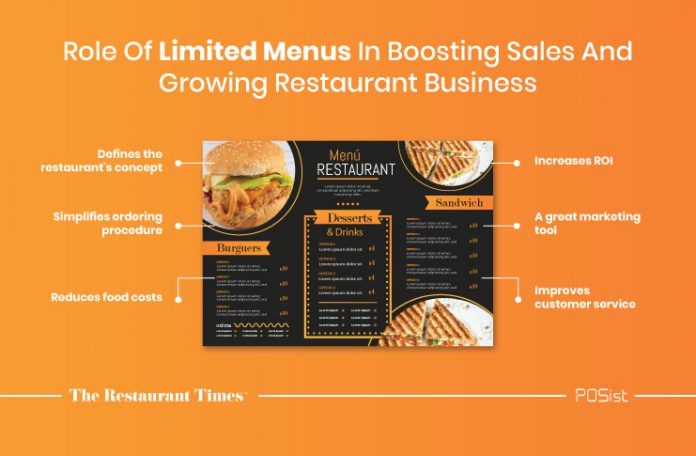Creating a menu is a crucial task for dining establishments, but it can sometimes be tricky. However, a bigger menu is not always better. In fact, it is advisable to keep the menu short from the point of view of controlling operating costs and improving customer experience. As revealed by a research study conducted at Columbia University, a limited menu with fewer options eases the process of decision making for the customers. Based on the changing customer behavior, restaurants have started introducing limited menus to provide an eatery-like feel to customers and boost their sales.
For many years, restaurants have provided a wide range of dishes in their menus because the more the number of options a restaurant offers, the less likely that customers will go for other eateries. However, an expanded menu creates confusion in the customer’s mind as to what to order.
This article aims to show how a limited menu helps the restaurant boost its sales.
7 Reasons Why Limited Menus Are Better Than Comprehensive Ones
Nowadays, every restaurateur is reviewing their menu to optimize it according to the COVID-19 scenario and the changing consumer trends. Many brands are going for limited menus as they are less expensive than the stretched a-la-carte menus.
Here are some reasons why adopting a limited menu can be fruitful for your restaurant business.
1. Improves Food Quality
An extensive menu suggests that your restaurant prefers quantity over quality. Having too many items on the menu affects the kitchen operations and increases the chances of inconsistencies in taste and quality. A kitchen that simultaneously works on various dishes has a higher chance of discoordination and thus, delivers slower service.
On the other hand, a limited menu solves these problems. You can ask for feedback from customers and consider their opinion in designing the menu to attract more customers. A limited menu also enables the chefs to focus on a few but high-quality dishes, thereby improving the overall quality of the restaurant food. Post COVID-19, customers have become highly conscious about the food that they order. Thus, good food quality gives customers a sense of assurance and satisfaction, thereby attracting good reviews.
2. Simplifies Ordering Procedure
Extended menus offer customers plenty of choices that create a phenomenon known as ‘decision fatigue’, making the ordering procedure challenging. However, limited menus rid the customers of this problem and make the online ordering procedure smoother.
The online ordering procedure is also a part of customer service. The easier the procedure, the better the customer service. A limited, easy-to-read menu with good and attractive descriptions satisfies the customers and lets them place the orders quickly and comfortably.
3. Reduces Food And Labor Costs
Limited menus contribute significantly to reducing food and labour costs. Since there are fewer items to offer, there is a requirement of less inventory and less staff for its preparation. High food costs can thus be curbed by limiting the menu. Tracking of each ingredient becomes easier with fewer options, leaving no space for inventory wastage. The reduced food wastage further makes room for reducing food costs. A good inventory management software can be used to track the usage of every food ingredient.
While designing a limited menu, many ingredients can be cross-utilized for multiple dishes. You can order in bulk from wholesalers and negotiate better deals with them, cutting down on inventory costs.
A stretched menu needs more manpower to cook all the different cuisines and dishes. However, offering fewer dishes allows a reduced staff size, which is also an excellent way to keep the costs down amidst COVID-19.

4. Increases Return On Investment (ROI)
With the food costs being reduced, it is pretty evident that a limited menu increases the Return On Investment (ROI) of the restaurant. Trimmed menus enable even the high-cost items to generate profit. If your restaurant is focused on a specific cuisine, for instance, Chinese, Continental, etc., limited menus could be highly beneficial as they grab customers’ attention and create good brand recall.
You can also supplement your existing menu with an extra menu to experiment with new items. Creating a different menu for each day as “Menu of the Day” is a good way to promote your menu, making the customers come back to your restaurant and increase the ROI.
5. A Great Marketing Tool
Limited menus serve as a great marketing tool for restaurants. Smaller menus give better visibility into what it has to offer and are also visually appealing. The latest trends can be followed to design a limited menu to make them attractive for the customers. Short and sweet menus make it more likely for the customers to choose your restaurant over the competitors.
Furthermore, introducing separate menus for the new items you aspire to offer can effectively let your customers know about the latest offerings.
6. Creates Better Brand Awareness
A menu reflects the restaurant’s brand. It highlights the concept of your restaurant and establishes the brand firmly. A limited menu conveys the restaurant brand better as it includes only those dishes that resonate with the restaurant’s theme. Conversely, if you are offering numerous cuisines to your customers, they could get confused about your brand’s speciality.
For instance, if your restaurant only caters to the audience that likes burgers and fries, having a pumpkin shake on the menu makes no sense. One should make a note of what works for the customers before cutting down on the menu items. It is advisable to only include those things in your menu that have the capability of boosting your business.
7. Tricks Customers Into Ordering More
Limited menus can trick customers into ordering more. Extended menus baffle customers’ minds due to which they take more time to analyze the menu and end up ordering the same thing that they usually order. When the items offered are limited, customers are relieved from the decision-making pressure. It appears to them from the short menu that whatever they will order will not be enough. Hence, they end up ordering more than usual, thereby increasing your outlet’s sales.
Of course, limited menus are not a viable option for every restaurant. But, they can certainly prove to have a better effect on sales than comprehensive menus, if incorporated properly. In the wake of COVID-19 especially, limited menus can be really beneficial in cutting down on restaurant costs.

















